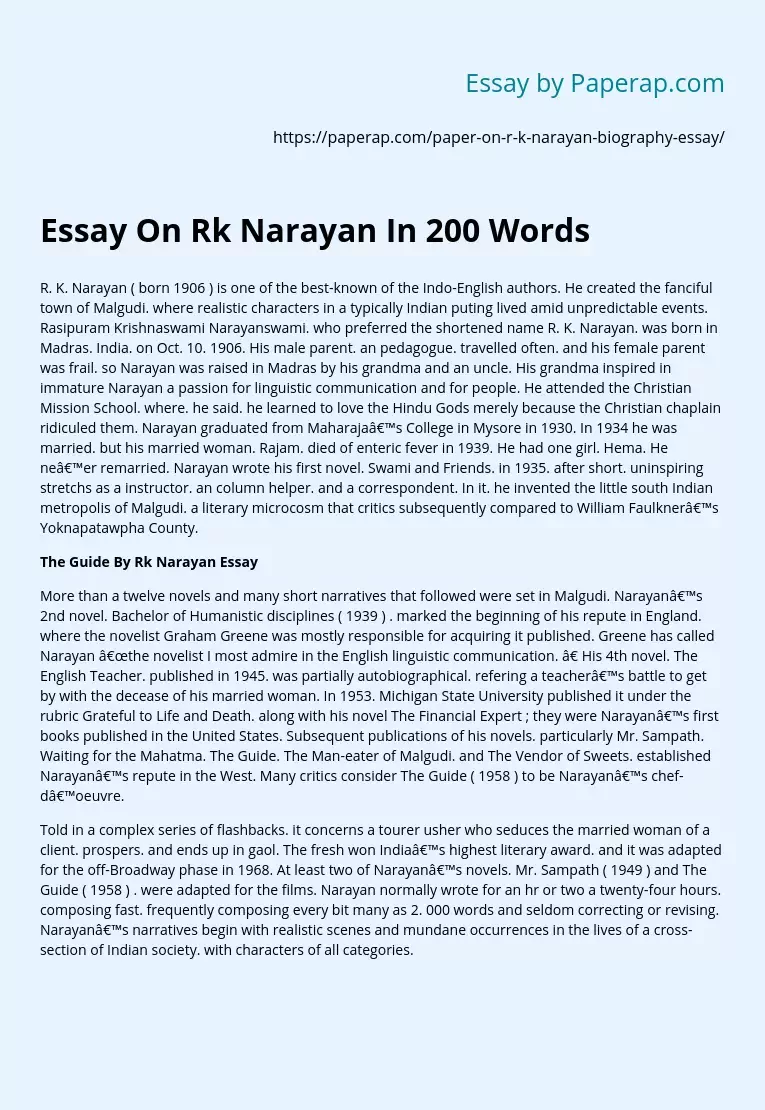Essay On Rk Narayan In 200 Words
R. K. Narayan ( born 1906 ) is one of the best-known of the Indo-English authors. He created the fanciful town of Malgudi. where realistic characters in a typically Indian puting lived amid unpredictable events. Rasipuram Krishnaswami Narayanswami. who preferred the shortened name R. K. Narayan. was born in Madras. India. on Oct. 10. 1906. His male parent. an pedagogue. travelled often. and his female parent was frail. so Narayan was raised in Madras by his grandma and an uncle. His grandma inspired in immature Narayan a passion for linguistic communication and for people.
He attended the Christian Mission School. where. he said. he learned to love the Hindu Gods merely because the Christian chaplain ridiculed them. Narayan graduated from Maharaja’s College in Mysore in 1930. In 1934 he was married. but his married woman. Rajam. died of enteric fever in 1939. He had one girl. Hema. He ne’er remarried. Narayan wrote his first novel. Swami and Friends. in 1935. after short. uninspiring stretchs as a instructor. an column helper.
and a correspondent. In it. he invented the little south Indian metropolis of Malgudi. a literary microcosm that critics subsequently compared to William Faulkner’s Yoknapatawpha County.
The Guide By Rk Narayan Essay
More than a twelve novels and many short narratives that followed were set in Malgudi. Narayan’s 2nd novel. Bachelor of Humanistic disciplines ( 1939 ) . marked the beginning of his repute in England. where the novelist Graham Greene was mostly responsible for acquiring it published. Greene has called Narayan “the novelist I most admire in the English linguistic communication.
” His 4th novel. The English Teacher. published in 1945. was partially autobiographical. refering a teacher’s battle to get by with the decease of his married woman. In 1953. Michigan State University published it under the rubric Grateful to Life and Death. along with his novel The Financial Expert ; they were Narayan’s first books published in the United States. Subsequent publications of his novels. particularly Mr. Sampath. Waiting for the Mahatma. The Guide. The Man-eater of Malgudi. and The Vendor of Sweets. established Narayan’s repute in the West. Many critics consider The Guide ( 1958 ) to be Narayan’s chef-d’oeuvre.
Told in a complex series of flashbacks. it concerns a tourer usher who seduces the married woman of a client. prospers. and ends up in gaol. The fresh won India’s highest literary award. and it was adapted for the off-Broadway phase in 1968. At least two of Narayan’s novels. Mr. Sampath ( 1949 ) and The Guide ( 1958 ) . were adapted for the films. Narayan normally wrote for an hr or two a twenty-four hours. composing fast. frequently composing every bit many as 2. 000 words and seldom correcting or revising. Narayan’s narratives begin with realistic scenes and mundane occurrences in the lives of a cross-section of Indian society. with characters of all categories. Reviewing Narayan’s 1976 novel The Painter of Signs. Anthony Thwaite of the New York Times said Narayan created “a universe as richly human and volatile as that of Dickens. ”
His following novel. A Tiger for Malgudi ( 1983 ) . is narrated by a tiger whose holy maestro is seeking to take him to enlightenment. It and his 14th novelTalkative Man ( 1987 ) received assorted reappraisals. In his 80s. Narayan continued to hold books published. He returned to his original inspiration. his grandma. with the 1994 book Grandmother’s Tale and Other Stories. which Publishers Weekly called “an model aggregation from one of India’s most distinguished work forces of letters. ” Donna Seaman of Booklist hailed the aggregation of short narratives that spanned over 50 old ages of Narayan’s composing as “an first-class sampling of his short fiction. by and large considered his best work” from “one of the world’s finest narrators. ” Narayan one time noted: “Novels may tire me. but ne’er people. ”
R. K. Narayan was born in Madras. South India. in 1906. and educated at that place and at Maharaja’s College in Mysore. His first novel. Swami and Friends and its replacement. The Bachelor of Arts. are both set in the enrapturing fictional district of Malgudi and are merely two out of the 12 novels he based at that place. In 1958 Narayan’s work The Guide won him the National Prize of the Indian Literary Academy. his country’s highest literary award. In add-on to his novels. Narayan has authored five aggregations of short narratives. including A Horse and Two Goats. Malguidi Days. and Under the Banyan Tree. two travel books. two volumes of essays. a volume of memoirs. and the re-told fables Supreme beings. Devils and Others. The Ramayana. and the Mahabharata. In 1980 he was awarded the A. C. Benson Medal by the Royal Society of Literature and in 1982 he was made an Honorary Member of the American Academy and Institute of Arts and Letters. Narayan died in 2001.
Plants of R. K. Narayan ( a ) Novels:1. Swami and Friends ( 1935 )2. Bachelor of Art ( 1973 )3. The Dark Room ( 1938 )4. The English Teacher ( 1945 )5. The Guide ( 1958 )6. The Painter of Signs ( 1976 )( B ) Narrative Collections:1. Malgudi Days2. Dodu and Other Narratives3. Cyclone and Other Narratives4. Supreme beings. Devils and Others ( 1964 )( degree Celsius ) Autobiography:1. My Days ( 1974 )2. My Dateless Diary ( 1960 )( vitamin D ) Other Plants:1. Ramayana. It is an English version of the Tamil heroic poem by Kamban
Essay On Rk Narayan In 200 Words. (2019, Dec 05). Retrieved from https://paperap.com/paper-on-r-k-narayan-biography-essay/

